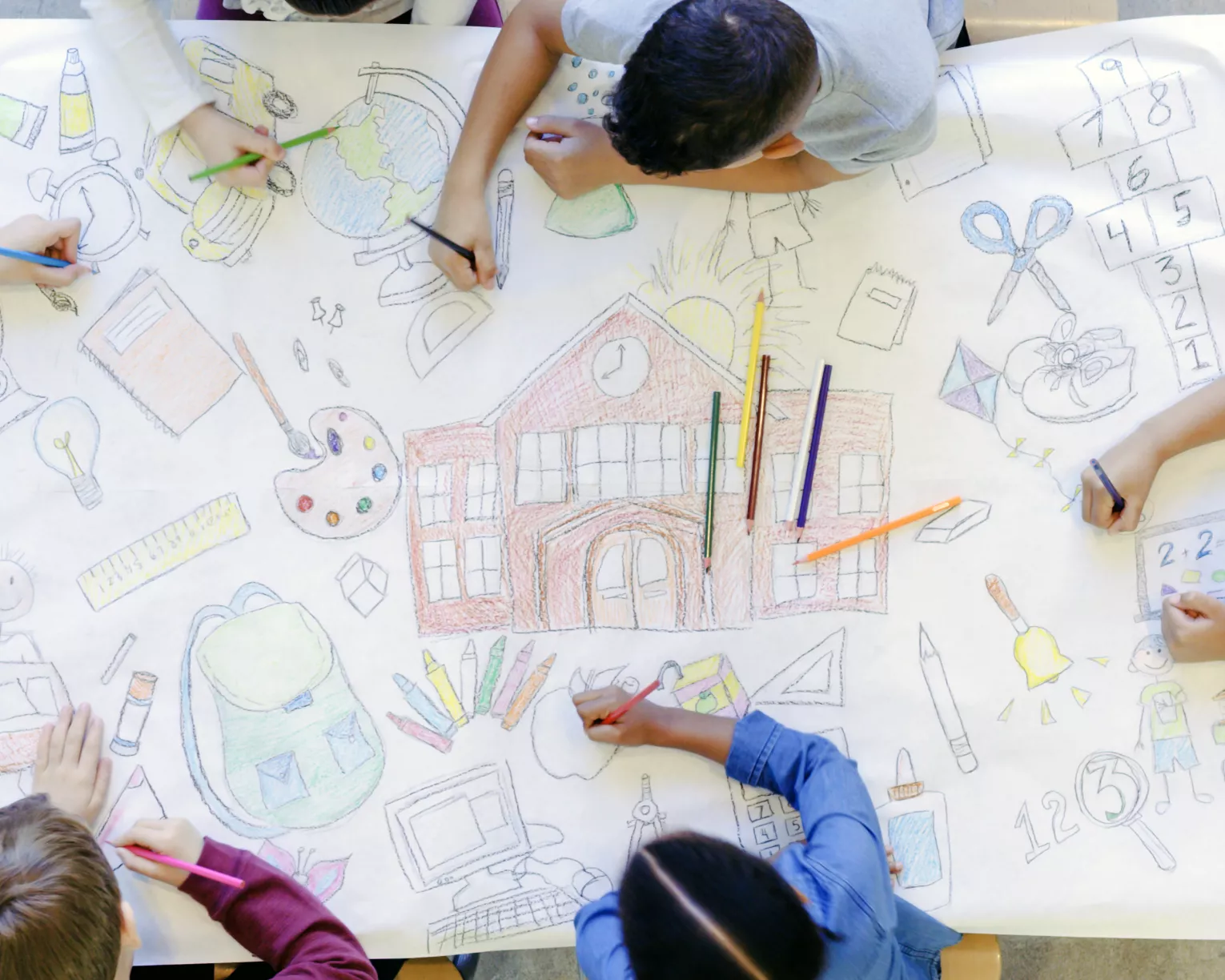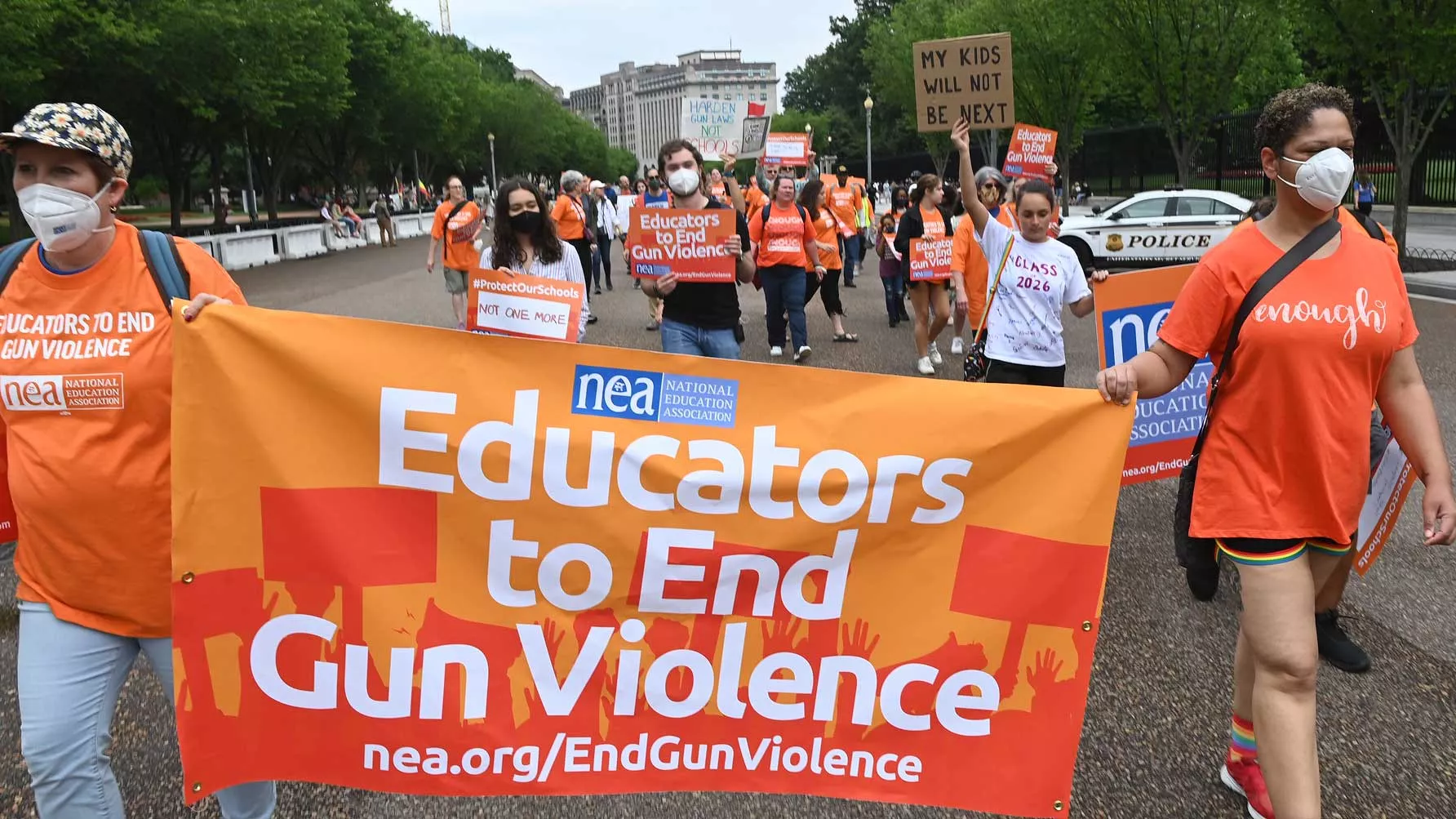Key Takeaways
- Educators are among the millions of Americans whose lives are forever changed by gun violence, in their schools and in their towns.
- The Bipartisan Safer Communities Act brings desperately needed progress in addressing America’s epidemic of gun violence, and includes funding for mental health resources in schools.
- Gun safety advocates are energized by the new law, but much more needs to be done to ensure safe schools and communities for all.
Every student and educator in America deserves a safe and welcoming learning environment, free from the fear of gun violence in their school or community. But, for far too long, school shootings and the threat of violence have shattered that sense of safety.
The passage last week of the Bipartisan Safer Communities Act—the most significant new federal gun safety legislation in almost three decades—brings desperately needed progress in addressing America’s epidemic of gun violence.
The need for federal action
Columbine, Newtown, Parkland, and countless other schools and communities are now forever linked to horrific acts of violence. And the recent shootings at Robb Elementary School in Uvalde, Tex., and the hate-filled massacre in Buffalo, N.Y., have only underscored the tragic consequences that result from easy access to firearms in the U.S.
There have been more than 2,654 mass shootings—attacks in which four or more people are shot, excluding the shooter—in the U.S. since 2012, when 20 children and six educators were killed at Sandy Hook Elementary School.
Gun violence is a public health crisis that touches every facet of society. While mass shootings at supermarkets and movie theaters to nightclubs and schools garner much attention, they are only a small percentage of gun-related deaths. In 2016, mass shootings represented less than 2 percent of nearly 39,000 gun-related deaths, according to CDC data. More than 14,000 of those deaths were homicides and far more, almost 23,000, were suicides.
America's gun violence crisis disproportionately hurts marginalized communities and communities of color. For example, Black Americans are 10 times more likely than white Americans to die from it. And Black children and teens are 14 times more likely to die by gun homicide than their white counterparts.
This epidemic also has an outsized impact on children and youth across the country. Children and adolescents under the age of 19 are more likely to die of firearms-related injuries than any other cause, with 45,222 firearm-related deaths reported in the United States in 2020.
Jim Klipfel, a U.S. history teacher and swimming coach at Saugus High School in Santa Clarita, Calif., has experienced the horrors of a school shooting. Klipfel was one of the first educators on the scene in 2019 after a student at his school shot five classmates, killing two of them, before shooting himself. In the case of the Saugus shooting, the 16-year-old perpetrator carried out the shooting using an unregistered “ghost gun” he assembled from a kit.
Klipfel said that the bipartisan legislation is a morale booster for schools and public education, especially for students, educators, and communities grappling directly or indirectly with gun violence.
"What we just witnessed is a good step, and also an acknowledgment that there’s still a lot that can be done,” Klipfel said.
Judi Richardson, an educational technician and behavioral health professional with the Portland Public Schools in Maine, has also experienced the pain of gun violence firsthand. In 2010, Richardson’s 25-year-old daughter, Darien, was fatally shot during a home invasion in Portland. Investigators have been unable to solve the case because the firearm used in the shooting was purchased without a background check from a private seller at a gun show.
Richardson said that bipartisan support for the legislation signals a shift in gun safety efforts and is helping to energize gun safety advocates working on other needed policy changes.
"People sometimes don’t want to get involved in this because they say it’s a losing battle,” Richardson said. “And this bill gives people hope for addressing gun violence. It’s baby steps, but we’re going in the right direction, and we can build on it.”
What’s in the Bipartisan Safer Communities Act
The Bipartisan Safer Communities Act, signed into law by President Joe Biden on Saturday, is the most significant gun safety initiative since the mid-1990s, when bipartisan majorities in the House and Senate supported bills requiring federal background checks on many gun purchases and a 10-year ban on assault weapons.
The legislation was the result of negotiations by a handful of Democratic and Republican senators, led by Sens. Chris Murphy (D-Conn.) and John Cornyn (R-Tex.), after the recent mass shootings in Uvalde and Buffalo. While previous gun safety proposals have broken down during negotiations, this legislation garnered bipartisan support in both the House and Senate.
The new law includes a number of provisions that educators and other advocates have long supported, including allocating millions of dollars to school safety programs and mental health services for children and families.
The bill provides $750 million in federal funding for states to create and manage crisis intervention programs, including the implementation of red flag laws that allow judges to temporarily remove firearms from individuals believed to be a threat to themselves or others.
The legislation also expands background checks for gun buyers under the age of 21, requiring that juvenile records and potentially disqualifying mental health records be included in the National Instant Criminal Background Check System (NICS), which was established by the 1993 Brady Handgun Violence Prevention Act. It also gives NICS up to 10 days to conduct background checks of prospective firearm purchasers between the ages of 18 and 21.
The bill also closes the so-called “boyfriend loophole” by expanding the current law that restricts individuals convicted of domestic violence or under a domestic violence restraining order from purchasing a firearm to include dating partners. And it creates criminal penalties for gun trafficking and “straw purchasers” of firearms, or those who buy guns for individuals who are barred from purchasing their own weapons.
The Path Forward
While the Bipartisan Safer Communities Act is a step in the right direction that will undoubtedly save lives, it is not a panacea for ending gun violence in our schools and communities. That’s why educators and other advocates must continue to press their local, state, and federal lawmakers to take additional common sense steps to address gun violence, while also celebrating the bipartisan legislation that has broken through years of political gridlock.
Richardson said that additional steps, such as requiring universal background checks, are critically needed to help address gun violence. NEA is also advocating for an assault weapons ban.
“Educators need to be worried about the safety of all kids, not just those in school but also those who come from homes with gun violence,” Richardson said. "And we can make a huge difference as a group to rise up and get involved.”
Humanizing these shootings by showing the wide-reaching impact they have on students, educators, and communities is also an important part of continuing to push for common sense safety measures.
“We need people who have experienced loss or the trauma of these experiences to tell their stories and share their concerns and offer some preventive strategies,” Klipfel said. “Not telling these stories dulls the reality and urgency of the problem.”
Even as educators and advocates celebrate passage of the Bipartisan Safer Communities Act and continue to examine other common sense gun safety measures, it’s important to remember that the fight to combat America’s gun violence epidemic is far from over.
This was made all the more evident last week when the Supreme Court struck down a New York law that required applicants for concealed carry permits to show that they had “proper cause” — a personal fear for their safety — that warranted the possession of a concealed firearm in public. By ruling that New York’s concealed carry law was unconstitutional, the 6-3 decision in New York State Rifle & Pistol Association Inc. v. Bruen also struck down similar gun licensing laws in California, Hawaii, Maryland, Massachusetts, New Jersey, and the District of Columbia.
In these locations, individuals will now be able to obtain permits for concealed weapons without needing to provide a proper cause. However, states are still able to require that objective criteria, such as passing a background check or undergoing safety training, be met in order to receive a concealed carry weapons permit. And while the Supreme Court’s decision does not undercut the recently passed gun safety legislation, it does open the door to more legal challenges to gun regulations all across the country at a time when the tide is shifting in favor of common-sense gun safety measures.
Despite the recent court decision, educators remain committed to ensuring that their students have the freedom to thrive and pursue their dreams in safe learning environments. Educators joined gun safety rallies, told their personal stories, and sent around 60,000 letters to Congress in support of the Bipartisan Safer Communities Act. After this historic legislative victory, they’re not about to stop advocating for other common sense gun safety measures.
“The 3 million members of the NEA, along with students and parents, are not going to back down until we take serious action to end gun violence in communities across this nation,” said NEA President Becky Pringle



